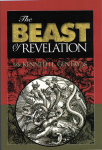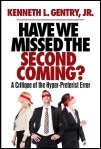SOME ANCIENT PRETERISTS
PMW 2025-042 by Kenneth L. Gentry, Jr.
 Since the 1990s the preterist perspective has been making its presence felt in contemporary prophecy discussions. Unfortunately, dispensational eschatology, which arose in the 1830s and is built on the futurist system, thoroughly dominates evangelical preaching, education, publishing, and broadcasting today. Consequently, evangelical Christians are largely unfamiliar with preterism, making it seem to be the “new kid on the block.” Preterism, however, is as hoary with age as is futurism. And despite its overshadowing in this century, it has been well represented by leading Bible-believing scholars through the centuries into our current day.
Since the 1990s the preterist perspective has been making its presence felt in contemporary prophecy discussions. Unfortunately, dispensational eschatology, which arose in the 1830s and is built on the futurist system, thoroughly dominates evangelical preaching, education, publishing, and broadcasting today. Consequently, evangelical Christians are largely unfamiliar with preterism, making it seem to be the “new kid on the block.” Preterism, however, is as hoary with age as is futurism. And despite its overshadowing in this century, it has been well represented by leading Bible-believing scholars through the centuries into our current day.
In this article I will list a few ancient representatives. Of course, the historicity of the view does not confirm the view — only its biblicity can do that. However, it is always good to be aware of the historical understanding of a doctrinal viewpoint. So let’s get started.
Eusebius
One of the best known and most accessible of the ancient preterists is Eusebius (A.D. 260-340), the “father of church history.” In his classic Ecclesiastical History he details Jerusalem’s woes in A.D. 70. After a lengthy citation from Josephus’s Wars of the Jews, Eusebius writes that “it is fitting to add to his accounts the true prediction of our Saviour in which he foretold these very events” (3:7:1-2.) He then refers to the Olivet Discourse, citing Matthew 24:19-21 as his lead-in reference and later Luke 21:20, 23, 24. He concludes: “If any one compares the words of our Saviour with the other accounts of the historian concerning the whole war, how can one fail to wonder, and to admit that the foreknowledge and the prophecy of our Saviour were truly divine and marvelously strange” (3:7:7).
The Beast of Revelation
by Ken Gentry
A popularly written antidote to dispensational sensationalism and newspaper exegesis. Convincing biblical and historical evidence showing that the Beast was the Roman Emperor Nero Caesar, the first civil persecutor of the Church. The second half of the book shows Revelation’s date of writing, proving its composition as prior to the Fall of Jerusalem in A.D. 70. A thought-provoking treatment of a fascinating and confusing topic.
For more study materials, go to: KennethGentry.com
The Clements
Another ancient document applying Matthew 24 to A.D. 70 is the Clementine Homilies (2d c.): “Prophesying concerning the temple, He said: ‘See ye these buildings? Verily I say to you, There shall not be left here one stone upon another which shall not be taken away [Matt. 24:3]; and this generation shall not pass until the destruction begin [Matt. 24:34]….’ And in like manner He spoke in plain words the things that were straightway to happen, which we can now see with our eyes, in order that the accomplishment might be among those to whom the word was spoken” (Clem. Hom 3:15).
Clement of Alexandria (A.D. 150-215) discusses Daniel’s seventieth week as a past event: “The half of the week Nero held sway, and in the holy city Jerusalem placed the abomination; and in the half of the week he was taken away, and Otho, and Galba, and Vitellius. And Vespasian rose to the supreme power, and destroyed Jerusalem, and desolated the holy place” (Miscellanies 1:21). The famed premillennialist Tertullian (A.D. 160-225) writes of the Roman conquest: “And thus, in the day of their storming, the Jews fulfilled the seventy hebdomads predicted in Daniel” (An Answer to the Jews, 8).
The Cappadocian Fathers
Even the Book of Revelation is applied to A.D. 70 by many in antiquity. In his Interpretation of the Revelation Andreas of Cappadocia (5th c.) noted that “there are not wanting those who apply this passage to the siege and destruction of Jerusalem by Titus” (Rev. 6:12). Later he commented: “These things are referred by some to those sufferings which were inflicted by the Romans upon the Jews” (Rev. 7:1). According to noted church historian Henry Wace, Andreas’s commentary is “the earliest systematic exposition of the book in the Greek church.” Andreas himself informs us that he wrote it in order “to unfold the meaning of the Apocalypse, and to make the suitable application of its predictions to the times that followed it.”
Arethas of Cappadocia (6th c.) also provides us a commentary on Revelation which, according to Wace “professes to be a compilation” though “no mere reproduction of the work of his predecessor, although it incorporates a large portion of the contents of that work.” Arethas specifically applies various passages in Revelation to A.D. 70 (Rev. 6-7).
Have We Missed the Second Coming:
A Critique of the Hyper-preterist Error
by Ken Gentry
This book offers a brief introduction, summary, and critique of Hyper-preterism. Don’t let your church and Christian friends be blindfolded to this new error. To be forewarned is to be forearmed.
For more Christian educational materials: www.KennethGentry.com
Kenneth L. Gentry Jr.'s Blog
- Kenneth L. Gentry Jr.'s profile
- 85 followers



